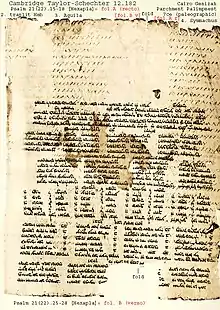Taylor-Schechter 12.182
The siglum Taylor-Schechter 12.182 (T-S 12.182; also referenced as TM nr. 62326; LDAB id: 3490; Rahlfs 2005) designates a manuscript written on parchment in codex form. This is a palimpsest of a copy of Origen's work called the Hexapla. This is a manuscript dated to 7th-century C.E.[1] This manuscript is the oldest of the hexapla.[2] The hexapla was completed before the year 240 C.E.

History
The fragments comes from Egypt, were published by C. Taylor in his work Hebrew-Greek Cairo Genizah Palimpsests, Cambridge, 1900, pp. 54–65.[3]
Description
This is palimpsest in codex form written on parchment. It contains Psalms 22 (LXX 21): 15-18 fol. A recto,19-24 and 25-28 fol. B verso, and the middle columns, 2-5 columns of the Hexapla.[4][5]
Tetragrammaton ΠΙΠΙ
The manuscript is written in koine Greek, and the divine name is notable, it contains the tetragrammaton in Greek characters "Pipi" (ΠΙΠΙ). According to Jerome, some septuagint manuscripts had the Divine Name written in this way. Jerome mentions that some Greek manuscripts contain the Hebrew letters YHWH,[6] he also comments that this Hebrew could mislead some Greek readers to read YHWH as "Pipi" (ΠΙΠΙ), since the letters YHWH (read right to left) look like Pi Iota Pi Iota (read left to right) in Greek.[7] According to Pavlos D. Vasileiadis and Nehemiah Gordon the manuscript has "the nomen sacrum κ[ύριε] with a supralinear Hebrew yod for יהוה (YHWH), followed by πιπι. This transitional combination represents the Tetragrammaton in Ps 22:20 [LXX 21:20] in three separate ways in the Septuagint column of Origen’s Hexapla, preserved in a palimpsest in the Cairo Genizah."[8]
Actual location
Today it is kept at the Library of the University of Cambridge as a part of the Taylor-Schechter Cairo Genizah Collection (Cambridge University Library T-S 12.182).
References
- R. Jenkins, in: A. Salvesen, Origen's hexapla and fragments, Tübingen 1998, p. 88-102
- Kantor, B. (2019-03-01). "The Oldest Fragment of Origen's Hexapla: T-S 12.182". Taylor-Schechter Fragment of the Month. Taylor-Schechter Genizah Research Unit, Cambridge University Library. doi:10.17863/CAM.45329.
- Charles Taylor (1900). Hebrew-Greek Cairo Genizah palimpsests from the Taylor-Schechter collection. Cambridge: Oxford University. pp. 1–50.
- "Chronological List of Early Papyri and MSS for LXX/OG Study (plus the same MSS in Canonical Order appended)". Retrieved 2015-03-24.
- Ernst Wurthwein; Alexander Achilles Fischer (2014). Alexander Achilles Fischer (ed.). The Septuagint: The Hexapla of Origen. The Text of the Old Testament: An Introduction to the Biblia Hebraica. Translated by Erroll F. Rhodes. Wm. B. Eerdmans Publishing. p. 111. ISBN 9780802866806.
- Prologus Galeatus
- Letter 25 to Marcellus
- Vasileiadis, Pavlos; Gordon, Nehemia (2019). "Transmission of the Tetragrammaton in Judeo-Greek and Christian Sources («Η Μεταβίβαση του Τετραγράμματου στις Ιουδαιο-Ελληνικές και Χριστιανικές Πηγές»)". 18. Accademia: Revue de la Société Marsile Ficin: 25. ISSN 1296-7645. Cite journal requires
|journal=(help)
Sources
- Taylor, Charles (1900). Hebrew-Greek Cairo Genizatt Palimpsests from the Taylor-Schechter Collection including a Fragment of the Twenty Second Psalm According to the Origen's Hexapla. Cambridge University Press.CS1 maint: ref=harv (link)
External links
- Cambridge University Library T-S 12.182 on Cambridge Digital Library
- 'The oldest fragment of Origen's Hexapla: T-S 12.182', Genizah Research Unit's Fragment of the Month
- "The Hexapla". Artefacts of Ancient Judaism. Archived from the original on 2015-04-16. Retrieved 2015-03-09. A description of T-S 12.182
- Image 1
- University Library Taylor-Schechter Collection 12.182.jpg Image 2